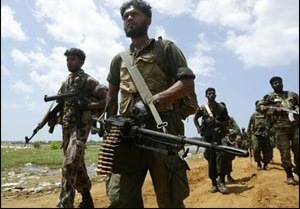 Even as it publicly refused to give Sri Lanka any offensive weapons for the war against LTTE, India had a "hidden hand" in the success of the island nation’s campaign over the terrorist outfit, says a new book.
Even as it publicly refused to give Sri Lanka any offensive weapons for the war against LTTE, India had a "hidden hand" in the success of the island nation’s campaign over the terrorist outfit, says a new book.
Although in the initial days he was advised to seek a negotiated settlement with the Tamil Tigers, New Delhi saw merit in Sri Lankan President Mahinda Rajapakse’s argument that the LTTE was only biding its time to regroup and rearm itself and that war was inevitable sooner than later, says ‘Sri Lanka, From War to Peace’, by journalist Nitin Gokhale.
Defence and Strategic Affairs Editor with NDTV, Gokhale covered the 33-month Eelam War in Sri Lanka.
The Mi-17s that India ‘quietly gifted’ to Lanka were in addition to a Sukanya class offshore patrol vessel also gifted by the Indian Coast Guard to the Sri Lankan Navy in 2002. The choppers played a major role in several daring missions launched by the Sri Lankan Air Force to rescue the army’s deep penetration units and injured soldiers from deep inside LTTE-held territory, the book says.
"Hampered by domestic compulsion, New Delhi could not go beyond such meagre and clandestine transfer of military hardware. Publicly all India was willing to acknowledge was the supply of low-flying detection "Indra" radars to the Sri Lankan Air Force since this equipment was considered a defensive apparatus," the author says.
Gokhale quotes senior Sri Lankan army officers saying that thanks to the Mi-17s, the soldiers operating behind enemy lines functioned with a greater degree of confidence since they knew these choppers were always at hand to come to their rescue whenever necessary. This surely was the key factor in our Special Forces delivering spectacular results.
Not wanting to annoy its Tamil Nadu allies like the DMK unnecessarily, New Delhi had a ‘politically most important message’ conveyed to Colombo to try and conclude the war against the LTTE (called Eelam War IV) before the summer of 2009 when India was expected to hold the general elections, Gokhale says.
"The Rajapakse regime was nothing if not shrewd". Aware of dynamics that determined India’s Lankan policies, it was also conscious of India’s anxiety in losing strategic space in Sri Lanka. The Rajapakse brothers were pragmatic enough to realize that Lanka needed India’s support in war against the LTTE, total support from China and Pakistan notwithstanding".
Colombo could ignore India but only upto a point, the
author says.
So Mahinda Rajapakse hit upon an idea of an informal exchange mechanism between New Delhi and Colombo. He nominated both his brothers – Basil (MP and Presidential advisor) and Gotabaya, the Defence Secretary along with his own secretary Lalith Weeratunga.
India too reciprocated immediately. The Indian team comprised National Security Advisor M K Narayanan, Foreign Secretary Shiv Shankar Menon and Defence Secretary Vijay Singh.
Colombo may have been ambivalent about meeting Indian requests to end the operations before the general elections but the Sri Lankan leadership once again gratefully acknowledged the Indian Navy’s contribution in locating and destroying at least 10 ‘floating warehouses’ owned by the LTTE that were used by the Tigers to store arms, ammunition and even armoured personnel carriers.
Well-coordinated operations by the two navies between 2006 and 2009 actually broke the backbone of the Sea Tigers, Gokhale says.
Also, under an agreement between the two countries, the Indian Navy and the Coast Guard frequently sent out ships to patrol the Palk Strait and the Gulf of Mannar. Presence of warships and Indian patrol vessels acted as firm deterrence against the Sea Tigers, the book says.
(For updates you can share with your friends, follow TNN on Facebook and Twitter )
